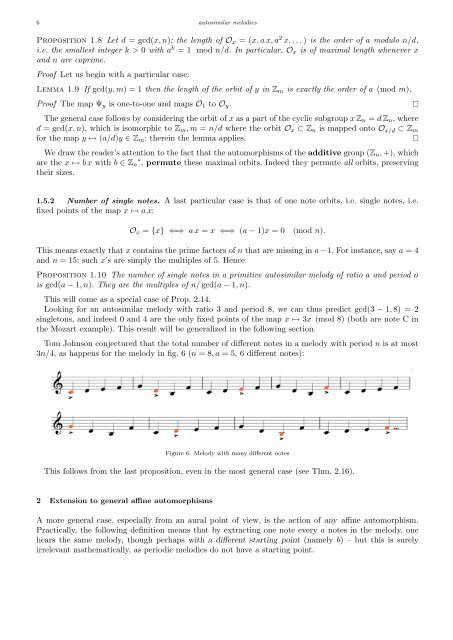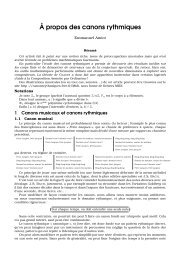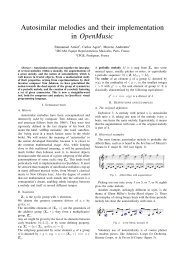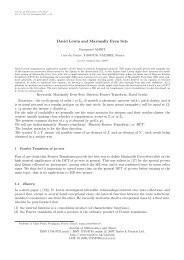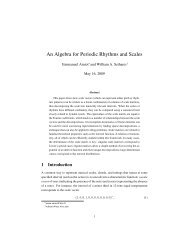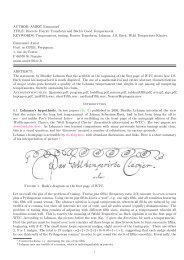Emmanuel Amiot Modèles algébriques et algorithmes pour la ...
Emmanuel Amiot Modèles algébriques et algorithmes pour la ...
Emmanuel Amiot Modèles algébriques et algorithmes pour la ...
You also want an ePaper? Increase the reach of your titles
YUMPU automatically turns print PDFs into web optimized ePapers that Google loves.
6 autosimi<strong>la</strong>r melodies<br />
Proposition 1.8 L<strong>et</strong> d = gcd(x, n); the length of Ox = (x, a x, a 2 x, . . . ) is the order of a modulo n/d,<br />
i.e. the smallest integer k > 0 with a k = 1 mod n/d. In particu<strong>la</strong>r, Ox is of maximal length whenever x<br />
and n are coprime.<br />
Proof L<strong>et</strong> us begin with a particu<strong>la</strong>r case:<br />
Lemma 1.9 If gcd(y, m) = 1 then the length of the orbit of y in Zm is exactly the order of a (mod m).<br />
Proof The map Ψy is one-to-one and maps O1 to Oy. <br />
The general case follows by considering the orbit of x as a part of the cyclic subgroup x Zn = d Zn, where<br />
d = gcd(x, n), which is isomorphic to Zm, m = n/d where the orbit Ox ⊂ Zn is mapped onto O x/d ⊂ Zm<br />
for the map y ↦→ (a/d)y ∈ Zm: therein the lemma applies. <br />
We draw the reader’s attention to the fact that the automorphisms of the additive group (Zn, +), which<br />
are the x ↦→ b x with b ∈ Zn ∗ , permute these maximal orbits. Indeed they permute all orbits, preserving<br />
their sizes.<br />
1.5.2 Number of single notes. A <strong>la</strong>st particu<strong>la</strong>r case is that of one note orbits, i.e. single notes, i.e.<br />
fixed points of the map x ↦→ a x:<br />
Ox = {x} ⇐⇒ a x = x ⇐⇒ (a − 1)x = 0 (mod n).<br />
This means exactly that x contains the prime factors of n that are missing in a−1. For instance, say a = 4<br />
and n = 15: such x’s are simply the multiples of 5. Hence<br />
Proposition 1.10 The number of single notes in a primitive autosimi<strong>la</strong>r melody of ratio a and period n<br />
is gcd(a − 1, n). They are the multiples of n/ gcd(a − 1, n).<br />
This will come as a special case of Prop. 2.14.<br />
Looking for an autosimi<strong>la</strong>r melody with ratio 3 and period 8, we can thus predict gcd(3 − 1, 8) = 2<br />
singl<strong>et</strong>ons, and indeed 0 and 4 are the only fixed points of the map x ↦→ 3x (mod 8) (both are note C in<br />
the Mozart example). This result will be generalized in the following section.<br />
Tom Johnson conjectured that the total number of different notes in a melody with period n is at most<br />
3n/4, as happens for the melody in fig. 6 (n = 8, a = 5, 6 different notes):<br />
Figure 6. Melody with many different notes<br />
This follows from the <strong>la</strong>st proposition, even in the most general case (see Thm. 2.16).<br />
2 Extension to general affine automorphisms<br />
A more general case, especially from an aural point of view, is the action of any affine automorphism.<br />
Practically, the following definition means that by extracting one note every a notes in the melody, one<br />
hears the same melody, though perhaps with a different starting point (namely b) – but this is surely<br />
irrelevant mathematically, as periodic melodies do not have a starting point.


